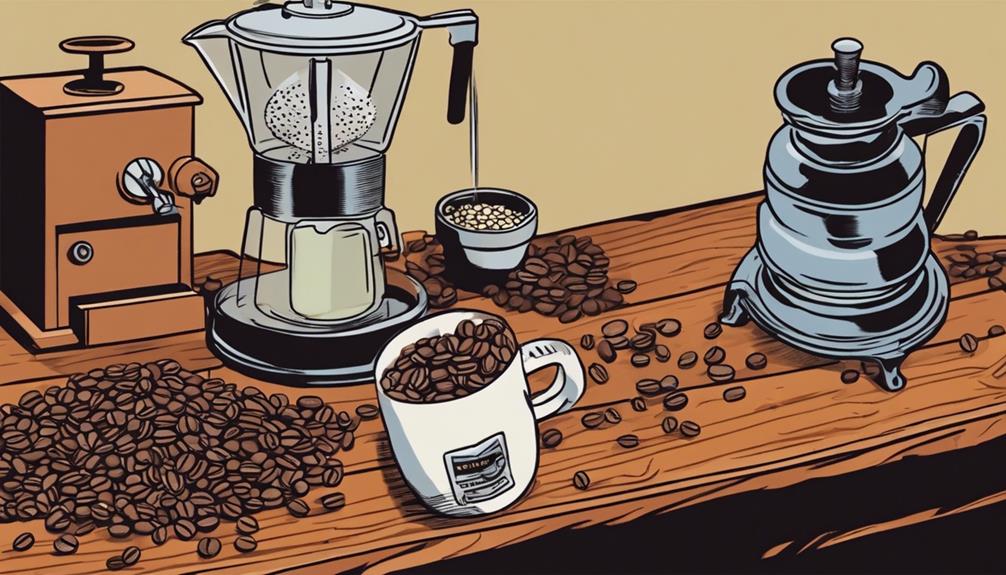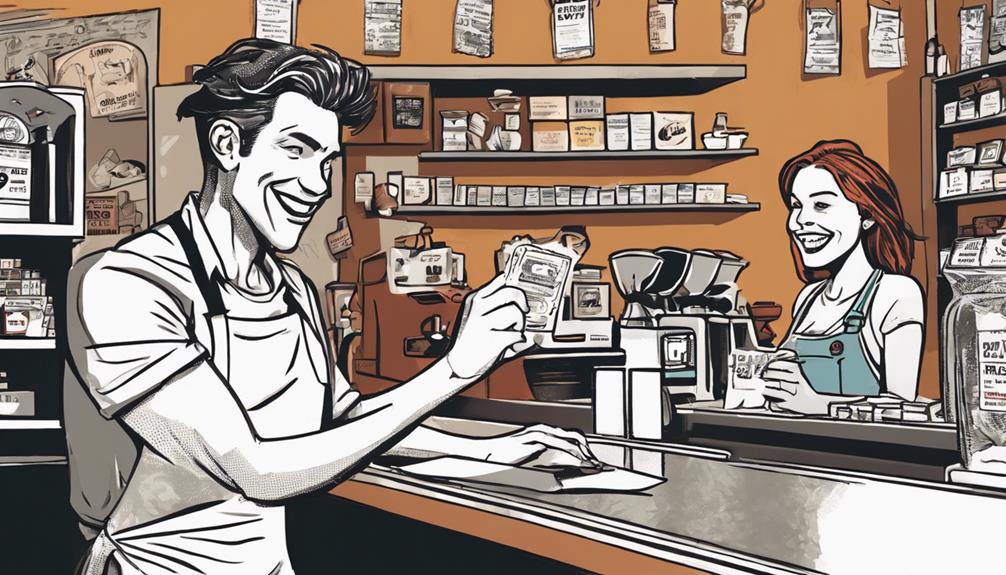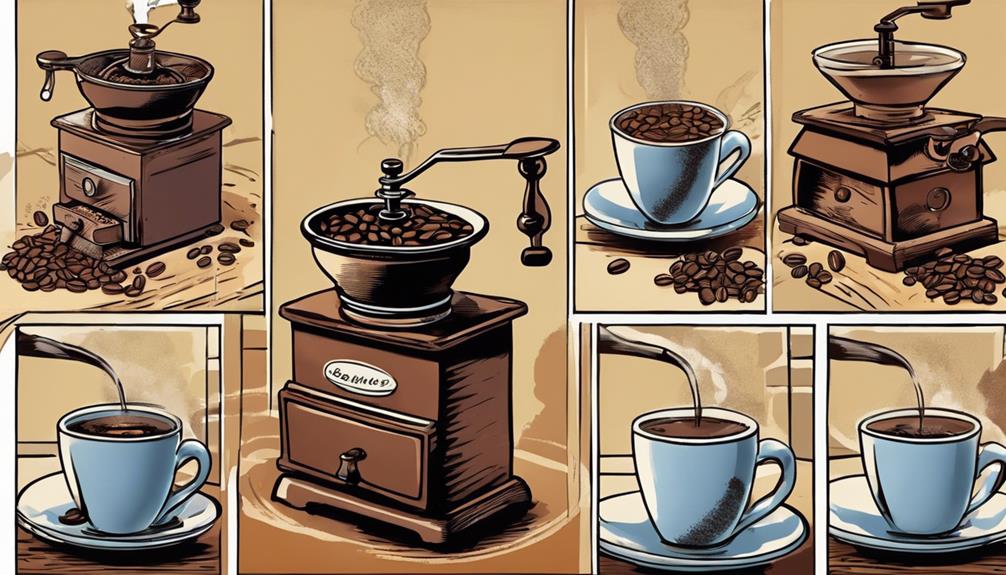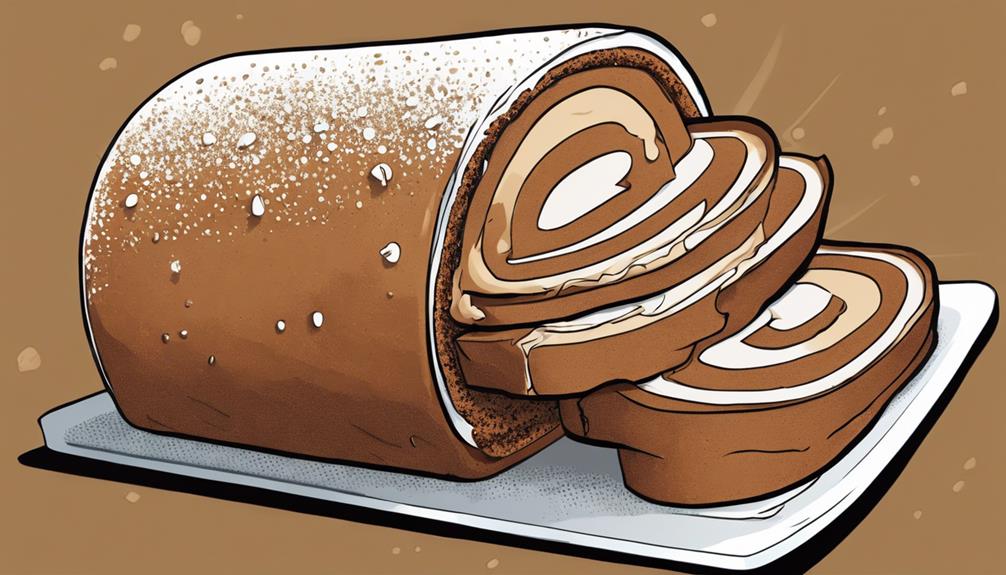Mix different types of beans to create the perfect cup! Learn about blending principles and mix beans together to create a harmonious blend of flavors. Each bean brings its own unique characteristics, so make sure to balance them out for a well-rounded taste. Take into account roast levels and flavor profiles when blending, and experiment with different ratios. Customize your blends based on the brewing method you prefer, whether it’s espresso or cold brew. Use beans from various origins to create complex profiles. You can also try adding spices or dried fruit for a DIY touch. Start with small batches and adjust the blend ratios until you find your ideal taste. Add different flavor elements to craft a personalized and delicious cup of coffee.
Key Takeaways
- Experiment with different bean combinations and ratios for unique flavors.
- Consider roast levels to balance taste and aroma in your blend.
- Keep detailed records to adjust and refine your perfect blend.
- Add flavor elements like spices or dried fruit for a personal touch.
- Start with small batches to fine-tune your blend for the perfect cup.
Blending Basics
To master the art of blending coffee, start by understanding the fundamental Blending Basics. When it comes to blending coffee, the magic lies in combining different beans to create a harmonious symphony of flavors.
Each coffee bean brings its own unique characteristics to the blend, adding depth and complexity to the final cup. By carefully selecting beans with complementary flavors, you can craft a blend that's greater than the sum of its parts.
Experimenting with different bean combinations allows you to play with the nuances of each coffee, revealing a world of possibilities. Whether you prefer a bold and rich blend or a more subtle and delicate one, the key is to balance the flavors to achieve a well-rounded cup.
Coffee Blending Techniques

Exploring various coffee blending techniques can elevate your coffee crafting skills to new heights, enhancing the depth and complexity of your brews.
When you blend coffee, consider the roast levels of the beans you're using. Lighter roasts often bring out bright acidity, while darker roasts offer richer, bolder flavors.
To create your own coffee blend, start by selecting beans with complementary flavor profiles. Experiment with different ratios of these beans to achieve a balanced and harmonious taste.
Remember, a blend can consist of up to five different coffees, each contributing to the overall flavor. Pay attention to the individual characteristics of each coffee to ensure they work together seamlessly.
Blending for Different Brewing Methods
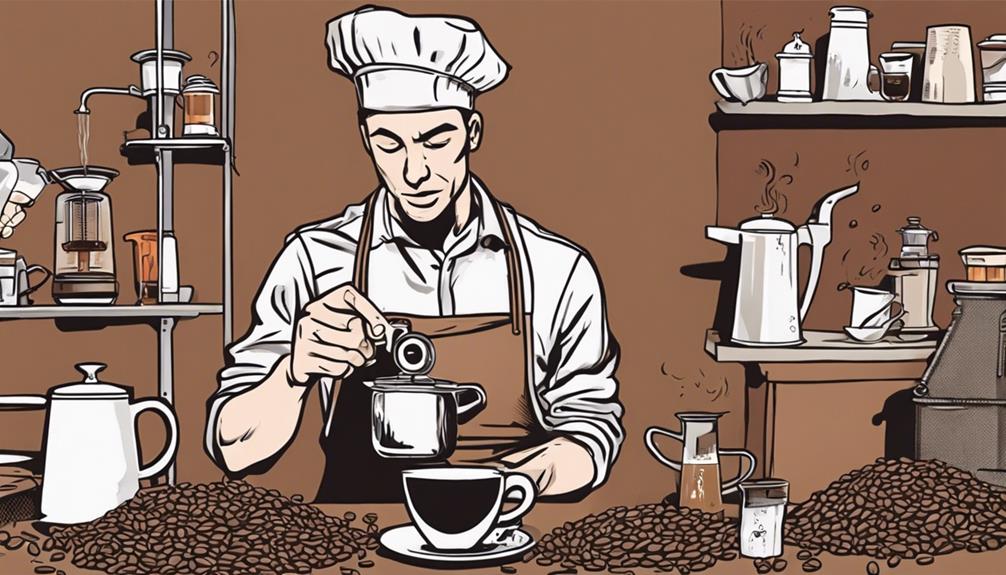
When blending coffee for different brewing methods, consider the specific characteristics of each method to enhance the flavor profiles of your brews.
For espresso, blending involves combining different roast levels to achieve a balanced and complex shot. The focus for cold brew blends is on using darker roasts to create a smooth, low-acidic coffee suitable for cold extraction.
Different blends are tailored for specific brewing methods such as filter-drip, espresso, and cold brew to enhance specific flavor profiles. Experimenting with various roasts and origins allows for customization of flavor profiles based on the brewing method at hand.
Blending techniques for espresso aim to achieve specific flavor profiles by combining different types of coffees in the blend. By understanding the nuances of each brewing method and utilizing appropriate blending techniques, you can create flavored coffee that perfectly complements the brewing style you prefer.
History of Coffee Blends

Blending coffee traces its origins back to the early days of coffee cultivation, where Dutch researchers introduced the Abyssinia 3 variety for mixing. This marked the beginning of a journey that led to the creation of intricate and flavorful blends enjoyed worldwide.
Mokha Java Blend: The fusion of Mokha and Java beans signified a pivotal moment in coffee blending history, marrying two distinct flavors to craft a unique taste experience.
Dutch Researchers: The innovative minds of Dutch researchers played an essential role in experimenting with different bean varieties, laying the foundation for modern coffee blending techniques.
Yemeni Coffees: Renowned for their spicy notes and rich crema, Yemeni coffees have become prized components in blends, adding depth and character to the final cup.
Varied Origins: Blends like the popular Mocha-Java combine beans from diverse regions like Indonesia, showcasing the art of combining different origins to create harmonious flavor profiles.
Espresso Blends Composition
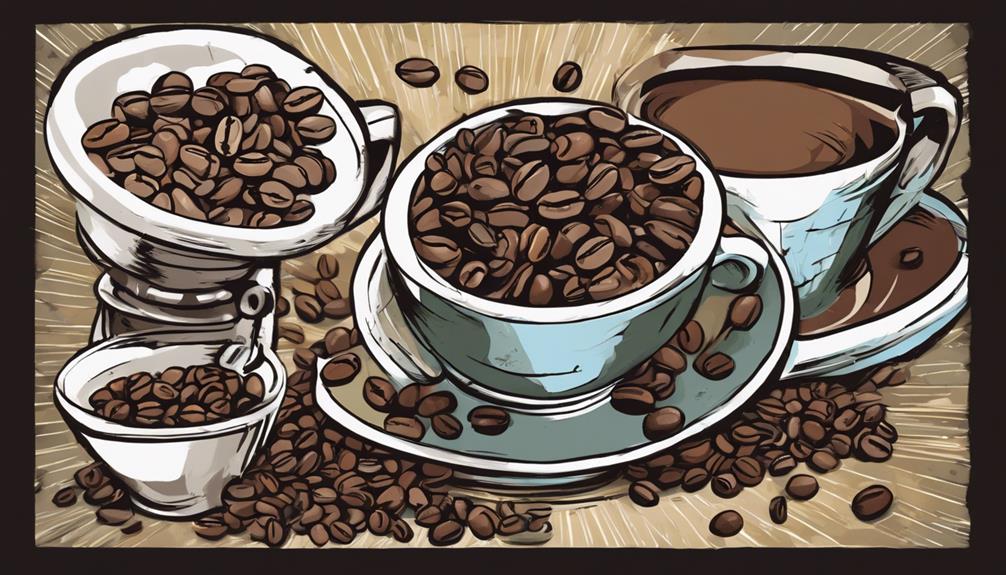
When crafting espresso blends, understanding the key components is essential for achieving the desired flavor profile.
Experimenting with different blend ratios allows you to fine-tune the balance of acidity, body, and crema.
Embracing new trends can lead to exciting flavor combinations in your espresso blends.
Key Espresso Components
Curious about what comprises the key components of espresso blends? When crafting the perfect espresso, comprehending the key elements that go into creating a balanced and flavorful blend is crucial. Here are the key elements that are vital:
- Base Coffee: High-quality Brazilian arabicas often form the foundation of espresso blends, providing a rich and smooth base for the flavor profile.
- Component Coffees: African and Central American coffees are incorporated into espresso blends to enhance acidity, body, and introduce fruity notes, adding complexity to the blend.
- Espresso Blends: Dry processed coffees are included in espresso blends to assist in crema formation, contributing to the overall mouthfeel and visual appeal of the espresso.
- Lighter Roasted: Current trends lean towards brighter coffees and lighter roasts in espresso blends, offering a more intricate and nuanced flavor profile that caters to the evolving tastes of coffee enthusiasts.
Grasping these key components will assist you in creating a well-balanced and delightful espresso blend that suits your preferences.
Blend Ratio Adjustments
Understanding the nuances of blend ratio adjustments in espresso blends is pivotal in achieving your desired flavor profile. When crafting espresso blends, tweaking the percentages of different coffee beans can significantly impact the final taste. Experimenting with various blend ratios allows you to balance the base, acidity, body, and fruity notes to create a harmonious flavor experience. For instance, increasing Central American coffee beans enhances acidity, while incorporating African beans adds fruity and floral undertones to the blend. Moreover, adjusting the blend ratio by reducing Robusta content leads to a smoother espresso with a more pronounced crema and less bitterness. By being mindful of each coffee bean's characteristics and making precise blend ratio adjustments, you can craft a well-rounded and flavorful espresso blend tailored to your preferences.
| Aspect | Impact |
|---|---|
| Central American | Enhances acidity |
| African | Adds fruity and floral notes |
| Robusta | Reduces bitterness, improves crema quality |
| Blend Ratios | Fine-tunes flavor profiles |
Espresso Flavor Experimentation
Crafting espresso blends involves selecting premium Brazilian arabicas as a base to enhance flavor richness and crema production.
When experimenting with espresso blends, consider incorporating beans from different origins and adjusting roast levels to create unique flavor profiles tailored to your preferences.
To achieve a well-balanced espresso blend, follow these steps:
- Begin with premium Brazilian arabicas for a rich base flavor and excellent crema.
- Add African and Central American coffees to enhance acidity, body, and fruity notes, increasing complexity.
- Experiment with various origins and roast levels to discover new and exciting flavor combinations that suit your taste.
- Consider including dry processed coffees to aid in crema development, an essential element of a high-quality espresso shot.
Decaf Blends Evolution

Decaf blends have greatly evolved in the coffee industry, offering unique options for decaf enthusiasts. Sweet Marias has introduced the Decaf Espresso Donkey Blend, showcasing the evolution of decaf blends and catering to those seeking decaffeinated alternatives. This blend exemplifies a shift towards providing high-quality decaf options that rival their caffeinated counterparts.
The evolution of decaf blends can be seen in the categorization of offerings into Standards and Espresso Workshop editions. These categories cater to different preferences, allowing consumers to choose blends that suit their taste profiles. The Workshop editions, in particular, follow the crop cycle of specific coffees, resulting in constantly evolving and distinctive decaf blend offerings.
Customers have provided positive feedback on the informative content accompanying these blends, which encourages experimentation in creating personalized decaf blends. This emphasis on education and exploration highlights the innovative approach that the coffee industry is taking towards decaf options.
DIY Blending Techniques
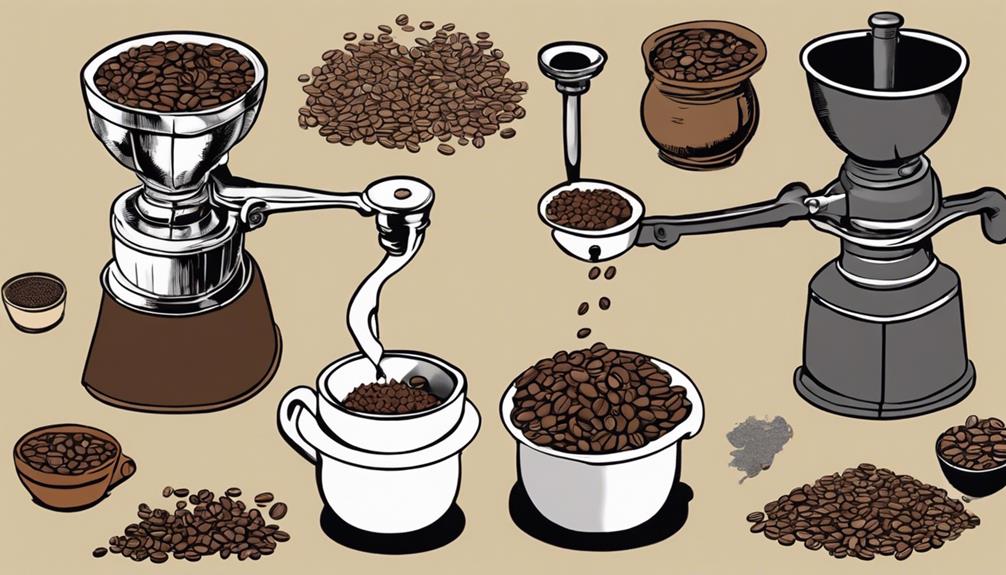
When blending coffee at home, start with small batches to experiment with different bean ratios. Keep detailed records of your blends to adjust and refine them for best taste.
Don't be afraid to add unique flavor elements like spices or dried fruit to customize your coffee blend to your liking.
Small Batch Experimentation
Begin your coffee blending journey by starting with small batches of beans to experiment with different ratios and flavors. By delving into small batch experimentation, you can discover a world of possibilities to create your perfect blend. Here are some essential tips to guide you through this process:
- Blending Ratios: Play around with varying proportions of different beans to find the ideal balance that suits your taste buds.
- Flavor Combinations: Mix beans with complementary flavor profiles to achieve a harmonious and rich taste in your blend.
- Roast Levels: Experiment with combining beans of different roast levels to add layers of complexity and depth to your coffee.
- Personalization: Enhance your blend by incorporating unique flavor elements such as spices or dried fruit for a personalized touch.
Remember to document your experiments meticulously to refine your blends gradually and replicate successful outcomes.
Small batch experimentation allows you to tailor your coffee blend to match your preferences and craft a truly distinctive coffee experience.
Blend Ratio Adjustments
Experimenting with blend ratios in small batches is key to customizing the flavor profile of your coffee blend. By adjusting the proportions of different coffee beans, you can fine-tune the taste to suit your preferences.
Start by combining varying ratios of beans with different roast levels to achieve a blend with complexity and depth. Keep detailed records of each adjustment you make to track the impact on the flavor profile. This meticulous approach will help you refine your process and get closer to that perfect cup of coffee.
To achieve a personalized touch, consider adding flavor elements like spices or dried fruit in precise amounts. However, remember that the primary way to tailor your blend is through blend ratio adjustments. This technique allows you to experiment with the balance of flavors until you find the ideal combination that matches your taste buds.
Through trial and error, you can discover the perfect blend ratio that makes your coffee truly exceptional.
Flavor Element Additions
Enhance your coffee blend by incorporating flavor elements like spices or dried fruit through DIY blending techniques. Experiment with these additions to create a unique and personalized cup of coffee that suits your taste preferences.
Here are some ideas to get you started:
- Cinnamon: Add a pinch of ground cinnamon to your coffee blend for a warm and aromatic flavor profile.
- Cardamom: Infuse your coffee with a hint of cardamom to bring a subtle citrusy and floral note to each sip.
- Dried Cherry: Mix in some dried cherry pieces for a sweet and fruity undertone that complements the rich coffee beans.
- Ginger: Incorporate grated ginger for a spicy kick that adds depth and complexity to your blend.
Remember to keep track of your experiments and adjust the quantities based on your preferences. Start small and gradually refine your blend to create a truly customized and delicious cup of coffee.
Coffee Processing Methods
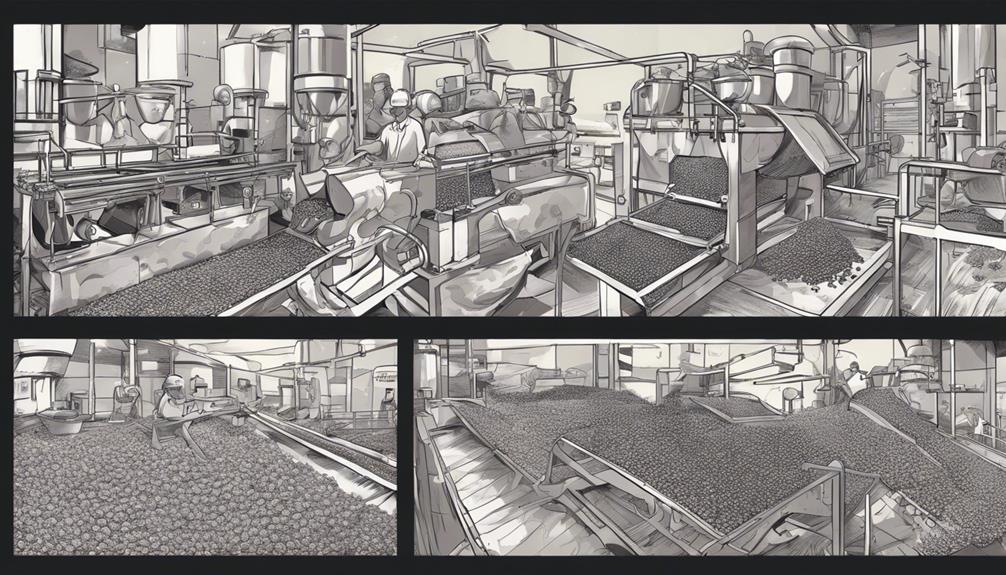
When processing coffee, various methods are utilized to extract and create different coffee products. Coffee processing involves the transformation of coffee beans from their raw form to the aromatic and flavorful beverage enjoyed worldwide. Roasting methods play a pivotal role in determining the final taste profile of the coffee, ranging from light to dark roasts.
Decaffeinated coffee is another popular variant that undergoes specific processes to reduce caffeine content while maintaining flavor. Methods like solvent-based decaffeination, such as soaking in methylene chloride or ethyl acetate, are commonly used. Additionally, pressure cooking in carbon dioxide or water soaking are employed to extract caffeine, resulting in decaffeinated coffee with up to 2.5% caffeine content.
Understanding the coffee processing methods allows you to appreciate the diverse range of coffee products available. Whether you prefer the convenience of instant coffee or the distinct flavor of decaffeinated coffee, each method contributes to the rich tapestry of coffee consumption.
Frequently Asked Questions
How to Make the Perfect Cup of Coffee at Home?
To make the perfect cup of coffee at home, start by selecting high-quality beans and experimenting with different ratios to achieve your desired flavor. Blend contrasting profiles for balance and grind just before brewing for freshness.
How Do You Make the Perfect Coffee Blend?
To make the perfect coffee blend, consider the origin, roast level, and flavor notes of each bean. Experiment with small batches, record ratios, and use high-quality, fresh beans. Adjust ratios until you find the ideal cup. Enjoy the process!
How Do You Grind a Perfect Cup of Coffee?
To grind a perfect cup of coffee, start by using a burr grinder for consistent results. Adjust grind size based on your brewing method. Remember, fresher beans mean better flavor. Experiment with grind size and brewing time for a customized coffee experience.
How to Make the Perfect Cup of Filter Coffee?
To make the perfect cup of filter coffee, use a medium to coarse grind size, guarantee water temp is 195-205°F, maintain a coffee-to-water ratio of 1:15 or 1:17, let it bloom for 30 secs, and experiment with different beans and roasts.
Conclusion
Now that you know the basics of blending coffee, you can create the perfect cup at home with ease. Experiment with different techniques and brewing methods to find your ideal blend. Not only will you be able to enjoy the perfect cup of coffee, but you can also explore the benefits of coffee powder on skin. Coffee grounds can be used as a natural exfoliant to help slough off dead skin cells, leaving your skin feeling smooth and rejuvenated. Additionally, the antioxidants in coffee can help reduce inflammation and protect the skin from environmental stressors. So, go ahead and indulge in the art of blending coffee while also reaping the benefits it can bring to your skincare routine.
The possibilities are endless, so don't be afraid to get creative and mix things up. Remember, the sky's the limit when it comes to crafting your own delicious coffee concoction!
